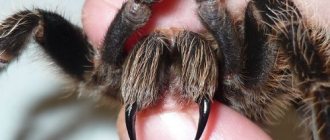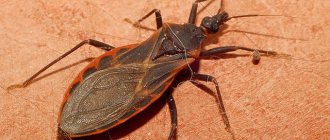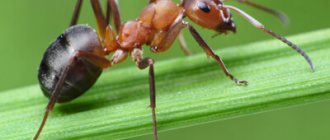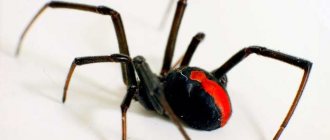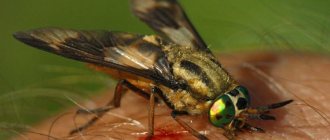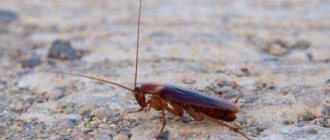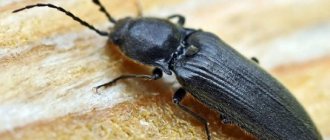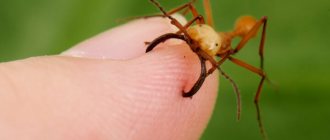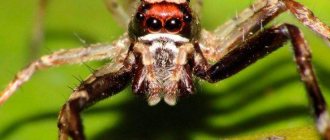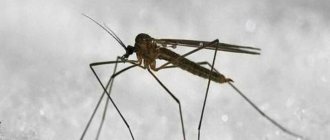They conquered all habitats (with the exception of oceans and seas), adapting to the most difficult living conditions. They can be found everywhere: in cities, forests, steppes, swamps, deserts and taiga. Highly organized individuals form the most extensive class - insects, which in terms of species diversity and numbers surpass all other animals on the planet. And it is the representatives of this class that are assigned a primary role in the multi-link food chain, in its subtlest elusive processes, as well as in soil formation, plant pollination and environmental sanitation.
Ants
Most people consider ants to be fairly harmless creatures: “They live in an anthill, work, mind their own business, and don’t really bother anyone.” They have a good reputation. But, in fact, ants are pests, they can carry various diseases and in some cases pose a danger to the human body.
Ants carry bacteria that can cause dysentery, cholera and salmonellosis. Ant eggs can be carriers of helminths, which is also dangerous for humans, especially for small children, who may unknowingly or accidentally eat them.
The bite of large ants can cause severe pain at the site of the bite, as well as itching, swelling and inflammation. And if you have allergies, then 3-4 ant bites can cause anaphylactic shock.
If you are bitten by an ant, it is recommended to lubricate the bite site with alcohol and also take an antihistamine.
Pest flies that live nearby
Melon fly
Among the insects there are garden pests: melon fly, raspberry fly, cherry fly, onion fly and cabbage fly. They should not be confused with Drosophila fruit flies, which, although they are close relatives, do not cause direct harm, as they feed on rotten fruits and berries.
This is interesting! Any fruit fly, unlike a fly, is a unique object of biological research: its genome largely coincides with the human genome. Most of our diseases have an analogue among these seemingly useless small insects. This is why the fruit fly is a valuable subject to study.
But let's return to garden pests. As you might guess, the cherry fly parasitizes cherries, the melon fly can destroy the harvest of honey-sweet fruits, and the raspberry fly attacks one of the healthiest berries. Onion larvae will eat the entire root crop. The cabbage fly is not particularly discerning and eats all cruciferous vegetables. The arrival of such pests in the garden is a real disaster. Adult insects feed on liquid food, but the larvae feed on the fruits in which the females deposit them. If you notice insects circling over the beds and garden trees, slightly smaller than ordinary flies, but very similar to them, immediately destroy them, otherwise the crop will be destroyed!
Cabbage fly
The cabbage fly eats cruciferous vegetables, including wild ones. Its invasion is especially dangerous for the garden due to its widespread distribution. The cabbage fly is one of the most voracious parasites on vegetable crops.
Hessian fly
Another pest that is dangerous on a larger scale is called the Hessian fly. Its larvae feed on cereals, preferring wheat and rye. The Hessian fly is more like a mosquito; it is not without reason that it is called the “bread mosquito.” According to legend, it came to our country with fodder brought by Hessian mercenaries back in 1776. It has taken root, become familiar, and causes enormous damage to domestic agriculture. The Hessian fly is dangerous because if the attack is not stopped in time, it can easily ruin the entire cereal harvest.
The forest pest is the fungus fly. Her children are the worms we all know, hopelessly spoiling boletus, boletus, russula, etc.
These insects are harmful and dangerous, but there are even worse ones. Let's get to know the bloodthirsty flies that bite.
Ticks
It is no secret that this problem is very acute in Russia. Every year in May-June, and in recent years even earlier, the season of ticks begins, which attack both animals and people. A tick bite can be very dangerous, as these arthropods are carriers of Lyme disease (borreliosis) and encephalitis. These diseases affect the nervous system and in some cases cause disability or even death.
A tick bite is almost painless and difficult to notice right away. Typically, a tick is discovered either during a detailed examination after a walk in nature, or when a well-attached tick begins to interfere, and the bite area becomes inflamed and begins to hurt and itch.
It is very important to remove the tick correctly. You cannot tear off the tick body with your hands, because it is necessary to completely get rid of the insect. The bite site should then be smeared with iodine, and the tick should be taken to the nearest laboratory to make sure that it was not a carrier of a particular disease. During the quarantine period this is problematic, but necessary.
If there are a lot of ticks in your area, it is recommended to get vaccinated regularly. You can always find out more about them from your family doctor. This also applies to pets, for whom tick bites can be fatal.
Ancient organism
Determining the origin of the class of insects has proven somewhat difficult for scientists. The main problem was the lack of fossils of them to reveal phylogenetic relationships. For a long time, based on morphological comparisons, centipedes were considered to be closely related to insects. But the construction of phylogeny (the development of an organism over time) and recent morphological studies have indicated that insects are much closer to crustaceans, and not to millipedes.
Crustaceans are familiar from deposits of the early Cambrian period (about 541 million years), while insects are found in the fossil record only in the Devonian system (about 419 million years). The assumption of their origin from a single ancestor contains a time interval of more than 100 million years, in which insects should already have existed. Recent morphological comparisons and evolutionary reconstructions based on genomic sequences confirm that insects are indeed found as descendants of crustaceans. According to the analyses, insects branched off from crustaceans in the early Devonian (or late Silurian). This verdict is consistent with both paleontological data and the resulting estimate based on molecular clocks.
Horseflies
In ordinary city or country life, you are unlikely to encounter horseflies. However, if you keep cattle or your property is near pasture, your risk of being bitten by a horsefly increases.
Horseflies bite very painfully, and the bite site almost immediately swells, becomes tight and hot. If you have an allergy, a horsefly bite can cause anaphylactic shock. Therefore, it is recommended to immediately consult a doctor and take an antiallergic drug. In addition, horseflies are carriers of such dangerous diseases as filariasis, tularimia and even anthrax.
Pusher flies
Pusher flies are small predatory insects that are found in almost all parts of the planet. These flies received this name because of their bizarre behavior. Before mating, during courtship, male tuskers gather in flocks and begin to perform peculiar dances. In this interesting way they attract the attention of females. In countries with a particularly warm climate, such performances can be observed throughout the summer.
In addition to the pleasant spectacle of dancing, males gain favor with females by bringing gifts. Usually these are dead small flies of other species, which the female eats after mating. But quite often male pushers turn out to be very greedy gentlemen. In the most unceremonious way, they take their gifts from the female in order to use them to attract another female for mating.
The body of the pusher fly is gray-brown in color and up to 15 mm long. The belly has 5–7 ring-shaped divisions. When at rest, the wings fit tightly to the back. The head is small and round with a long proboscis hanging down. The eyes of males are usually as close to each other as possible. In the oral apparatus of the fly there are lower and upper jaws in the form of four bristles. Insect larvae live in the ground.
If your animals suffer from horsefly bites, then try various remedies for horseflies to combat them: chemicals, traps or proven folk methods.
The Hessian fly can often be found on winter wheat, as it lays its eggs on this plant. How to deal with this pest of grains, read in this article.
A dog can become infected with lice eaters from another dog or simply by walking outside. What kind of parasite is this and what the consequences of infection may be, read the article at https://stopvreditel.ru/parazity/zhivotnyx/puxoedy.html link.
Bees
Bees can be very dangerous to people, as their venom is a strong allergen. Even if you are not allergic, a bee sting will cause pain and blister formation. In the case of a severe allergic reaction, the temperature may rise, convulsions, vomiting and other symptoms of severe intoxication are possible. You should be wary of a bee sting on the neck, as this can cause suffocation.
In case of a bee sting, it is necessary to remove the sting (if it remains in the body) and treat the bite with a sugar solution, honey or fruit juice. If the bite is on the neck or head, you need to take an antihistamine and seek help from a doctor.
It is worth noting that wild bees and ground wasps, which often hide in the grass, are no less dangerous. They are easy to step on with bare feet. You can also disturb the earthen hive and cause a massive attack.
Stinging
Stinging insects insert their sting under a person's skin and inject venom. A sharp burning sensation appears at the site of the bite. These insects have a social way of life - if you disturb one representative, you can incur persecution of a whole swarm.
Bees
A bee sting causes a sharp burning sensation, but does not require medical attention. The exception is when a person is allergic to the components of the poison: in this case, a bee sting can cause anaphylactic shock, and with it confusion, difficulty breathing, nettle fever and subsequent loss of consciousness.
When a bee stings, poison enters the human body, causing short-term pain and burning.
A bite to the head, oral cavity or blood vessels is especially dangerous. In rare cases, a stung person is fatal. A swallowed bee will cause a swollen throat and subsequent death.
The bee loses its sting after being stung, as a result of which it dies almost immediately, so killing it is pointless and even dangerous: a crushed insect releases a substance that calls other bees to help.
bumblebees
This is an environmentally beneficial insect that pollinates flowers. It is not afraid of frost, so its habitat extends all the way to the Arctic Ocean. Has impressive weight. The body dimensions reach 3 cm.
Bumblebees are not inclined to show aggression, including towards people passing by. However, the possibility of a bite cannot be ruled out. The sting of this insect can cause trouble for a person. The poison has an irritating effect on skin tissue and lowers blood pressure, which can lead to nausea and loss of energy. The person who has been bitten may require immediate hospitalization.
Bumblebees are peaceful insects, but their sting can cause a severe reaction in an allergy sufferer.
Wasps
Wasps are dangerous even alone, but when they gather in a swarm, they pose an almost mortal danger.
The habitat of insects extends from temperate latitudes to subtropics. They tend to build nests in attics, balconies and sheds. These insects have a poisonous sting and jaws and often attack everyone indiscriminately, calling on their relatives for help. Having landed on a person, they can sting him several times. A burning sensation and swelling with redness appear at the site of the bite. A bite to the face, tongue or larynx is especially dangerous.
A wasp sting is very painful and can cause swelling and irritation of the skin.
If there is an allergic reaction to the components of the substance, the effect can be unpredictable. A person may experience vomiting, dizziness, cardiac arrhythmia, loss of consciousness, and severe swelling of the bite area.
Common hornet
The similarities between a wasp and a hornet are obvious to every zoologist, but the hornet has a more massive size. The body length reaches 3.5 cm. The queens are much larger than the males.
People who have experienced a hornet bite compare it to being hit by a stick or pierced by a hot nail. In addition to pain, it can cause associated complications - rapid pulse, breathing problems, pallor. Loss of consciousness is also possible.
A hornet sting is accompanied by a severe allergic reaction, loss of consciousness is possible
Having established a nest, the hornets begin to patrol the area around it. The aggressive insects attack anyone who crosses the border, including other hornets. For this reason, it is worth going around their nests, not approaching them further than 5 m.
Hornets can even establish a nest in a summer cottage. In this case, you should contact a specialist to exterminate insects.
Asian huge hornet
Not all people have heard of this insect, but those who know the Asian hornet are rightly wary of it. It is famous for its large size, extremely aggressive behavior and the dangerous and deadly poison on its sting, which it injects in large quantities.
The Asian hornet is a giant insect whose venom contains a high concentration of a toxic substance.
The habitat is not so large - the main part of insects is concentrated in Primorye. The Asian representative of the hornet reaches more than 5 cm in length, with a wingspan of 7 cm. It poses a considerable danger to people, as it will undoubtedly attack them when it meets them. This type of hornet attacks bees, using them as food for its larvae.
At the moment of a hornet sting, a strong neurotoxin (mandorotoxin) is released into the blood of a person or animal, which causes anaphylactic shock and destruction of body tissue. The result of the meeting could be death.
Due to the special pheromone that the hornet secretes (acetylcholine), swarms of other insects flock to the stung area and begin to sting the person. About 300 people die from these insects every year.
Water scorpion
The water scorpion lives in freshwater bodies of standing water, avoiding pronounced currents. It has a frightening appearance and corresponding behavior: having laid in wait for the victim, the scorpion will make a tenacious grip and dig into it. The sharp proboscis can pierce human skin, so touching them is dangerous.
The water scorpion has a short and thick stinger that can pierce the skin and release a poisonous enzyme
This arachnid is small in size - from 1.7 to 4.5 cm in length. A flat oval or cylindrical body with powerful front legs, a proboscis, antennae on the head, and slightly protruding wings. Body color is gray-brown.
Scorpio swims poorly and flies even worse, barely rising above the surface of the water, preferring to move along its plane, climbing from plant to plant. But they do this very slowly, so they use camouflage for hunting, pretending to be a rotten leaf.
bumblebees
Bumblebees belong to the same family as bees. However, they are less aggressive and do not react to the presence of a person near their home. Insects fly low enough that you may not notice them in tall grass. However, it is worth considering that bumblebee venom is no less dangerous than bee venom. So, if you are bitten by a bumblebee, you should behave in the same way as if you were stung by a bee.
Lacewing
Attractive pale green insects prey on aphids and mites. Lacewings were the first to be specially bred to protect greenhouse plants from pests.
In summer, lacewings often fly into apartments - at night they are attracted to electric light
If you touch an insect, an unpleasant odor will appear. But lacewings are harmless to humans.
Hornets
An ordinary summer resident may encounter the common European hornet. This is one of the most poisonous insects found in our latitudes. This kind of acquaintance is unpleasant. Hornets are quite aggressive, have a large body and powerful mandibles (jaws) with which they can bite.
If you are bitten by a hornet, use the tips in the section about bees and be sure to consult a doctor.
Cochineal
Several species of insects from which the red dye carmine is made are collectively called cochineal. Carminic acid, which is the main component of paint, is extracted from female cochineal scale insects.
Ararat, oak, Mexican and Polish cochineal are combined under the general name cochineal.
Dyes from these insects were obtained back in the 6th century BC.
Blister beetle
One of the most dangerous insects found in the middle zone is the blister beetle. Most often, blister beetles are found in open areas and are attractive with their unusual metallic color (Spanish flies). On its elongated body there is a toxic substance - cantharidin, which can cause blisters and abscesses when it comes into contact with the skin (hence the name). If this poison enters the bloodstream, it can be fatal. In total, there are more than 70 species of blister beetles.
If you touch one of them, use adsorbents and take an antihistamine. Wounds caused by interaction with poison are difficult to heal.
Order Hymenoptera insects
The order of insects with membranous wings is second only to beetles and butterflies in terms of species diversity. According to various conclusions, it numbers from 150 to 300 thousand species. More than 16 thousand species of Hymenoptera are recorded in the fauna of Russia. These include both primitive horntails and sawflies, as well as insects with a more complex biology and highly organized nervous system - bees, wasps and ants.
In the description of the species of this order, the following distinctive features are highlighted: 4 membranous wings have a loose network of veins, they are also found without them (wingless forms also exist); oral apparatus of gnawing-licking (bees) and gnawing (ants, wasps) types; development with complete transformation. Many hymenopteran insects live in communities, and some of them are characterized by polymorphism. The composition of such a family is represented by one or several queens, a small number of males and many workers (sterile females). These species are characterized by nervous activity with predominant instinctive actions.
Hymenoptera play an important role in nature and also have important economic importance. Among them there are dangerous plant pests (nutworms, seed eaters, horntails), there are predatory forms (ants, wasps), and there are also human allies (bees, bumblebees).
Ordinary T-shirt
The common beetle also belongs to the family of blister beetles. 30 mg of the venom of such an insect can kill a large person. And the contact of poison on the skin, as in the case of Spanish flies, causes burns and abscesses, which are then difficult to heal. Most often, the ordinary T-shirt can be found in the southern regions and the Caucasus.
If you come into contact with beetles, it is recommended to wash the area where the poison got in with soap and water, drink an anti-allergenic drink and carefully monitor your condition. If weakness, dizziness or nausea occurs, you should immediately consult a doctor.
Green (carrion)
Despite its partiality to various kinds of carrion and sewage, this fly is a very beautiful insect with a glossy emerald body and translucent smoky wings with a faint openwork pattern. Its body length is about 8 mm. The fly's eyes are large, reddish, its abdomen is round, its cheeks are white. Green flies live mainly in dirty places : on decaying animal corpses, in manure, waste - but sometimes they can be
meet among flowering plants with a strong aroma. They feed on organic rotting matter, where they lay their eggs.
After mating, the female lays about 180 eggs. The egg has a grayish or light yellow tint. She tries to hide them as deep as possible in carrion, where they develop within 6–48 hours to the larval stage. The length of the larvae's body varies between 10–14 mm. After 3–9 days they leave their habitat and move to the soil to pupate. The pupal stage lasts from 10 to 17 days (depending on weather conditions), after which the insect emerges to the surface as an adult fly.
Mosquitoes and mosquitoes
Few people do not know how annoying a mosquito can be in a room at night, and few people like hordes of them on the street in the evening. Mosquitoes are not the most dangerous insects that await summer residents in the garden or on the plot. But do not forget that a mosquito can be a carrier of malaria, tularemia and other serious diseases. Also, the enzyme released by a mosquito when it bites a victim can cause allergic reactions.
Mosquitoes are found in Russia, Sochi, Abkhazia, and they have no fundamental differences with mosquitoes.
Experts recommend not scratching the bite, but rather disinfecting the area with a vinegar solution. Our forum members offer folk remedies:
Murmansk
I found it in the people's councils, maybe it will help?!
MOSQUITOES ARE A TROUBLE.
• Plant lavender, geranium, and thyme near the porch and under the windows - there will be fewer mosquitoes in the house. Melissa will help calm bees and protect people from being stung. If a bee does bite, first remove the sting and apply a potato or onion cut in half to the site of the bite.
• Apply fresh parsley juice to the bite site or soak a cotton swab in it and apply it to the wound.
• Juice from dandelion roots is applied to the bite areas. Apply plantain leaves to the wounds for 30 minutes. A tincture of calendula flowers with vodka (1:10) is applied to the bite area several times or a swab moistened with the tincture is applied for 10-15 minutes.
Order Lepidoptera
Insects of this order are valued with no less passion than works of art. Even the ancient Romans believed that lepidoptera (butterflies) were formed from the inflorescences of plants torn from the stems. Their wings are the most important feature: they have a thick covering of chitinous scales, the structure and arrangement of which determine the originality of the color. According to various estimates, butterflies currently number over 200 thousand species, from more than 200 families of insects. About 9 thousand species of the order live in Russia, famous representatives among them are: urticaria, cabbage grass, cat's eye, dawn, meadow jaundice, wine hawk moth and others.
Another significant feature of Lepidoptera is the structure of the oral apparatus. Most butterflies have a thin and long proboscis, a highly specialized sucking organ that was formed from modified mandibles. In some species the proboscis may be underdeveloped or absent. Some lower representatives of the order retained the gnawing (original) mouthparts.
According to systematization, 3 suborders are noted within the order: jawed, homoptera and heteroptera. Most species of Lepidoptera belong to the latter. In addition, there is a conditional division of butterflies into diurnal (club-whiskered) and nocturnal (different-whiskered) butterflies.
Midges (blood-sucking midges)
These insects are most often found in the taiga zone, but some subspecies could also appear in the latitudes familiar to our summer residents. Midge bites are painful because a toxic substance is injected into the wound during the bite, which prevents blood clotting. There is a burning and itching sensation around the bite. In general, the insect is not dangerous, but with multiple bites it can cause anaphylactic shock.
Karakurt
Although karakurt is translated from Turkic as “black insect,” it is, of course, not an insect, but a spider, one of the most dangerous in the world. The traditional habitat of karakurts is the southern regions of Russia, but recently cases of karakurt bites have also been recorded in the Saratov, Volgograd regions and even in the Moscow region. It is also found in more northern latitudes, but only in the summer - these spiders do not survive cold winters.
Karakurts are also called “steppe widows”, since it is the females that pose a threat to animals and humans; the males of these spiders are smaller and simply cannot bite through the skin. The female bites the skin with her chelicerae to a depth of 0.5 mm, so one of the emergency methods to prevent infection is to cauterize the bitten area with a lit match, but no later than two minutes after the bite. The main method of treatment for spider venom is the use of anti-karakurt serum and intravenous administration of novocaine, magnesium hydrogen sulfate and calcium chloride.
The karakurts themselves do not attack unless they feel threatened, so you need to be vigilant in their habitats.
Common cross
The common cross spider is the most common species of poisonous spider in Russia. Its body is quite large - up to 2.5 cm, the upper part of the abdomen is black-brown or with a red tint, as well as white spots in the shape of a cross. The cross breed lives in forests, on bushes, as well as in sheds, window openings and under canopies. The spider itself is not aggressive, but if disturbed, it can attack. The bite of the cross is painful and causes hemorrhage under the skin. The reaction to poison can vary from weakness to colic and headache. Tissue necrosis may develop at the site of the bite.
To avoid consequences, you must immediately wash the bite site with warm water and then apply a cold compress. If you have a headache, you should take a painkiller.
Order of Diptera insects
In terms of the number of species, this order of insects ranks fourth, ahead of the Coleoptera, Lepidoptera and Hymenoptera. The name “diptera” speaks of the main characteristic of the order: the preservation of only one front pair of wings. The second pair was modified in the process of evolution and is now represented by club-shaped outgrowths (halederes). Currently, science has described about 200 thousand species of dipterans from 150 families. On the territory of Russia, the most famous representatives of the order are: flies, mosquitoes, mosquitoes, biting midges, horseflies and gadflies.
In the order of Diptera insects there is a considerable variety of colors, sizes and body shapes. Moreover, the body shape can be either oblong and slender, or compactly short, as in some parasitic species. But despite the great diversity, dipterans have common characteristics: adult individuals have a sucking or licking type of mouthparts (proboscis), developed compound eyes, thin sensitive integuments and 5-segmented paws. Ontogenesis of insects proceeds with complete transformation.
Argiope
Argiope has a body of 1.2-1.5 cm, and a silvery abdomen with longitudinal lobes or transverse stripes of dark yellow or orange. This spider is distributed mainly in the central part of Europe. It feeds on grasshoppers and other insects, weaves beautiful webs in the grass, and usually lives in small colonies of up to 20 individuals.
Not aggressive, but if you pick up a female, she can bite. The bites are painful, and after a sharp pain the bite site goes numb. Numbness and pain in the bite area disappear within 2-6 days. They do not pose any particular danger.
Predatory species
The activity of predatory insects (entomophages) helps preserve and maintain balance in nature. They often turn out to be the main regulatory factor restraining the excessive reproduction of some herbivorous species.
Mantis. When describing an insect, the main feature is the front legs: the thigh and lower leg form a kind of grasping apparatus that acts like scissors. Adults feed on grasshoppers, flies, and small butterflies, while the larvae feed mainly on aphids. Praying mantises provide a classic example of “predator-in-waiting” behavior.
Ladybug. The diet of adult insects and their larvae consists of: spider mites, aphids, eggs and small butterfly caterpillars. These predators have a very good appetite. During its development, one larva absorbs up to 600-800 aphids, and an adult can eat up to 40 aphids per day.
Coleoptera ground beetles. In the description of the predatory species of the family, they distinguish a long upper jaw similar to a sickle (mandible), with which they firmly hold the prey. Insects move nimbly along the soil surface, destroying snails, caterpillars, slugs, phytophages and many other pests.
Predatory insects are an important biological factor in the fight against parasites. They are successfully used in agriculture, protecting fruit and berry orchards, vegetable fields and cereal crops.
